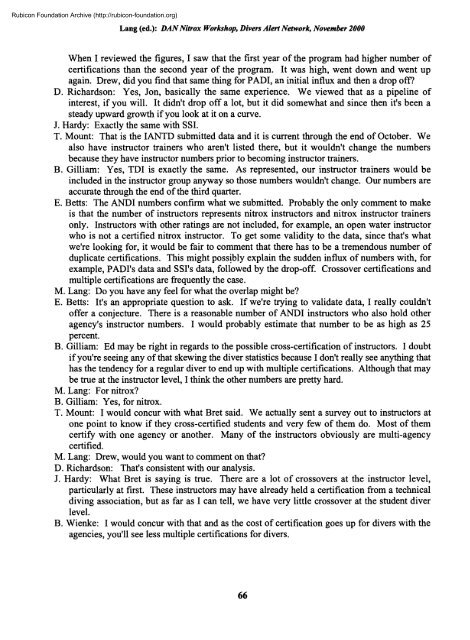Nitrox workshop dings - Divers Alert Network
Nitrox workshop dings - Divers Alert Network
Nitrox workshop dings - Divers Alert Network
You also want an ePaper? Increase the reach of your titles
YUMPU automatically turns print PDFs into web optimized ePapers that Google loves.
Rubicon Foundation Archive (http://rubicon-foundation.org)Lang (ed.): DAN<strong>Nitrox</strong> Workshop, <strong>Divers</strong> <strong>Alert</strong> <strong>Network</strong>, November 2000When I reviewed the figures, I saw that the first year of the program had higher number ofcertifications than the second year of the program. It was high, went down and went upagain. Drew, did you find that same thing for PADI, an initial influx and then a drop off?D. Richardson: Yes, Jon, basically the same experience. We viewed that as a pipeline ofinterest, if you will. It didn't drop off a lot, but it did somewhat and since then it's been asteady upward growth if you look at it on a curve.J. Hardy: Exactly the same with SSI.T. Mount: That is the IANTD submitted data and it is current through the end of October. Wealso have instructor trainers who aren't listed there, but it wouldn't change the numbersbecause they have instructor numbers prior to becoming instructor trainers.B. Gilliam: Yes, TDI is exactly the same. As represented, our instructor trainers would beincluded in the instructor group anyway so those numbers wouldn't change. Our numbers areaccurate through the end of the third quarter.E. Berts: The ANDI numbers confirm what we submitted. Probably the only comment to makeis that the number of instructors represents nitrox instructors and nitrox instructor trainersonly. Instructors with other ratings are not included, for example, an open water instructorwho is not a certified nitrox instructor. To get some validity to the data, since that's whatwe're looking for, it would be fair to comment that there has to be a tremendous number ofduplicate certifications. This might possibly explain the sudden influx of numbers with, forexample, PADI's data and SSI's data, followed by the drop-off. Crossover certifications andmultiple certifications are frequently the case.M. Lang: Do you have any feel for what the overlap might be?E. Betts: It's an appropriate question to ask. If we're trying to validate data, I really couldn'toffer a conjecture. There is a reasonable number of ANDI instructors who also hold otheragency's instructor numbers. I would probably estimate that number to be as high as 25percent.B. Gilliam: Ed may be right in regards to the possible cross-certification of instructors. I doubtif you're seeing any of that skewing the diver statistics because I don't really see anything thathas the tendency for a regular diver to end up with multiple certifications. Although that maybe true at the instructor level, I think the other numbers are pretty hard.M. Lang: For nitrox?B. Gilliam: Yes, for nitrox.T. Mount: I would concur with what Bret said. We actually sent a survey out to instructors atone point to know if they cross-certified students and very few of them do. Most of themcertify with one agency or another. Many of the instructors obviously are multi-agencycertified.M. Lang: Drew, would you want to comment on that?D. Richardson: That's consistent with our analysis.J. Hardy: What Bret is saying is true. There are a lot of crossovers at the instructor level,particularly at first. These instructors may have already held a certification from a technicaldiving association, but as far as I can tell, we have very little crossover at the student diverlevel.B. Wienke: I would concur with that and as the cost of certification goes up for divers with theagencies, you'll see less multiple certifications for divers.66
















